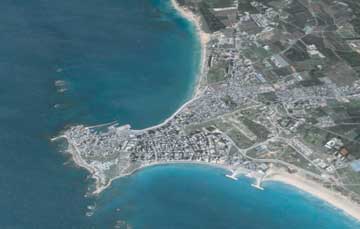|
NEWS NOTES — NEWS
Geoarchaeology
Sandbar led Alexander the Great to victory
 DigitalGlobe 2006 |
| Today, Tyre is connected to mainland Lebanon by an isthmus. Some 2,400 years ago, however, Tyre was an island, virtually impenetrable to conquerors such as Alexander the Great, who spent months trying to access the island. Eventually, the geology aligned and a sandbar became apparent — the sandbar was the island’s undoing. |
More than any battering ram, catapult or sword, Alexander the Great may owe his success in seizing the island of Tyre to waves and sand. In 332 B.C., after an unsuccessful seven-month blockade of the impenetrable island, Alexander reached Tyre by constructing a 1,000-meter causeway from what is modern-day Lebanon to the island. New research shows a shallow sandbar may have made this engineering feat — and the infamous fall of Tyre — possible.
Today, Tyre is no longer an island; it is fully connected to Lebanon by a sand isthmus, or tombolo, which formed as sediments piled up due to the action of waves passing around the island. Based on aerial photographs and ancient documents, previous research suggested a sandbar might have existed at the time of Alexander the Great, say Nick Marriner and Christophe Morhange, geoarchaeologists at the Centre National de la Recherche Scientifique in Aix-en-Provence, France, who led the new study. But until now no geological evidence supported this idea.
Using sediment cores and computer models, Marriner and his colleagues reconstructed the area’s geological history over the past 8,000 years. A sandbar was indeed present at the time of Alexander’s military operations, they report in the May 29 Proceedings of the National Academy of Sciences, making the water only 1 to 2 meters deep. “Prior to our research,” Marriner says, “there were no real estimates for water depth.” Alexander might have noticed the sandbar, suggests Jean-Daniel Stanley, a geoarchaeologist at the Smithsonian National Museum of Natural History in Washington, D.C., who was not involved in the study, by spotting “wave breaks at the water surface above the underlying shallower area” of the water.
Marriner and the team also found that people played a role in the sandbar’s formation. Coastal erosion caused by farming and deforestation helped increase the rate of sedimentation between the island and the mainland. This rate of accumulation would have also increased after the construction of Alexander’s bridge, which, Stanley says, would have “served as a nucleus to trap more and more sediments.”
In addition to solving a historical question, this study demonstrates how “you can use nature to your advantage,” says Stanley, who says we often have negative views on what geological processes, such as erosion, do to coastal areas. But in this case, they were helpful — at least if you were Alexander the Great.

 Subscribe
Subscribe


